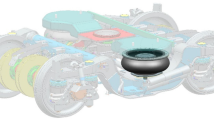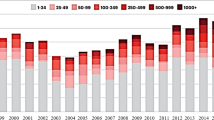Abstract
Normally, automobile bumper system absorbs the collision kinetic energy by deflection in low-speed crash and by deformation in high-speed crash. The main component of this system is the bumper beam, generally made of steel. The purpose of this paper is to improve energy absorption and light the weight of bumper by applying Fruit Fly Optimization Algorithm (FOA) in frontal bumper beam. The simulation of the frontal crash by using the Finite Element (FE) model is based on the New Car Assessment Program (NCAP). The most important parameters including the type of materials, thicknesses and layup of composite layers are studied by Rescaled Range Analysis (RRA). Then, the diminution of the value of Head Injury Criterion (HIC) is treated as optimization objective in the simulation of FE model, the thicknesses of composite beam are designed and analyzed through Fruit Fly Optimization Algorithm (FOA). In addition, the optimization results are compared with the results analyzed by Genetic Algorithm (GA). It can be observed from the results that the value of HIC is reduced by 6.37 %, the new composite beam will be just 4.84 % lighter than the steel part, and its peak value of collision energy absorption is 1.36 times larger than that of the steel part. In conclusion, the FOA can be applied in design of the new composite bumper beam in improving energy absorption and lightweight.






Similar content being viewed by others
References
Avalle M, Chiandussi G, Belingardi G (2002) Design optimization by response surface methodology: application to crashworthiness design of vehicle structures. Struct Multidiscip Optim 24:325–332
Belingardi G, Beyene AT, Koricho EG, Martorana B (2015) Alternative lightweight materials and component manufacturing technologies for vehicle frontal bumper beam. Compos Struct 120:483–495
Beyene AT, Koricho EG, Belingardi G, Martorana B (2014) Design and manufacturing issues in the development of lightweight solution for a vehicle frontal bumper. Proc Eng 88:77–84
Box GEP, Hunter WG, Hunter SJ (1978) Statistics for experimenters. Wiley, New York, pp 245–280
Cochran WG, Cox GM (1950) Experimental designs (second ed.). Wiley, New York, pp 117–133
Davoodi MM, Sapuan SM, Yunus R (2008) Conceptual design of a polymer composite automotive bumper energy absorber. J Mater 29:1447–1452
Davoodi MM, Sapuan SM, Aidy A, Abu Osman NA, Oshkour AA, Wan Abas WAB (2012) Development process of new bumper beam for passenger car: a review. Mater Des 40:304–313
Donald R, Askeland (2009) Materials science and materials engineering [M]. Nelson Engineering, Wyoming
Finney DJ (1955) Experimental design and its statistical basis. Cambridge University Press, London, pp 45–67
Fisher RA (1960) The design of experiments, (seventh ed.). Oliver and Boyd, London, pp 70–92
Gu XG, Sun GY, Li GY, Huang XD, Li YC, Li Q (2013) Multiobjective optimization design for vehicle occupant restraint system under frontal impact. Struct Multidiscip Optim 47:465–477
Hurst HE (1951) Long-term storage-capacity of reservoirs. Trans Am Soc Civ Eng 116:770–808
Jansson T, Nilsson L, Redhe M (2003) Using surrogate models and response surfaces in structural optimization - with application to crashworthiness design and sheet metal forming. Struct Multidiscip Optim 25:129–140
Jin R, Chen W, Simpson TW (2001) Comparative studies of metamodeling techniques under multiple modeling criteria [J]. Struct Multidiscip Optim 23(1):4–6
Libo C, Jie C, Zhigao O, Shi L (2012) Lightweight design and optimization of bumper beam based on automobile crash safety [J]. China Mech Eng 23:2888–2890
Marzbanrad J, Alijanpour M, Kiasat MS (2009) Design and analysis of an automotive bumper beam in low-speed frontal crashes. Thin-Walled Struct 47:902–911
Montgomery DC (2000) Design and analysis of experiments, 5th edn. Wiley, New York
National Crash Analysis Center (NCAC) (2001) Public finite element model archive. <www.ncac.gwu.edu/archives/model/index.html>
Pan W-T (2012) A new fruit fly optimization algorithm: taking the financial distress model as an example [J]. Knowl-Based Syst 26:69–74
Parrish A, Rais-Rohani M, Najafi A (2012) Crashworthiness optimization of vehicle structures with magnesium alloy parts. Int J Crashworthiness 17(3):259–281
Sapuan S, Maleque M, Hameedullah M, Suddin M, Ismail N (2005) A note on the conceptual design of polymeric composite automotive bumper system. J Mater Process Technol 159:145–151
Song HW, Wang ZHM, Du XW (2000) Experimental study on the impact absorption behavior of compound tubes [J]. J Exp Mech 15(4):408–415
Zhong ZH, Zhang WG, Cao LB (2003) Automobile crash safety technology [M]. China Machine Press, Beijing
Zipeng Z (2011) Research on the frontal longitudinal beam composite design and absorption characteristics. Harbin Institute of Technology, Harbin
Author information
Authors and Affiliations
Corresponding author
Rights and permissions
About this article
Cite this article
Zeng, F., Xie, H., Liu, Q. et al. Design and optimization of a new composite bumper beam in high-speed frontal crashes. Struct Multidisc Optim 53, 115–122 (2016). https://doi.org/10.1007/s00158-015-1312-2
Received:
Revised:
Accepted:
Published:
Issue Date:
DOI: https://doi.org/10.1007/s00158-015-1312-2




